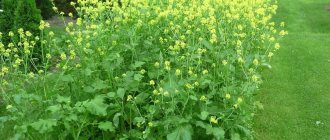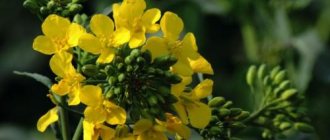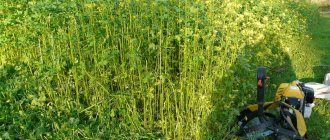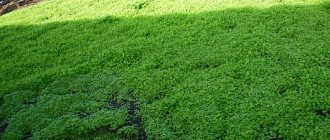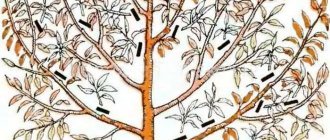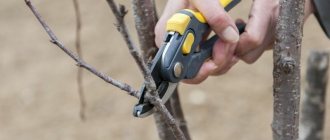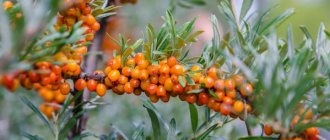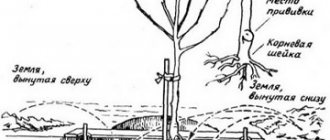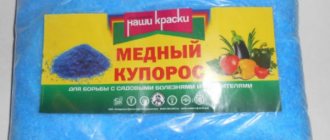Category: Vegetable garden
In pursuit of a rich harvest, you must always remember that any chemical fertilizers, protective equipment, and even the plants themselves deplete the soil.
You can improve crop rotation, increasing productivity, in an environmentally friendly way, using green manure . Green manure crops are specially grown to improve the structure of the soil, enrich it with nutrients and microelements, and inhibit the growth of weeds. Sadzavodi.ru will answer your questions about what green manure is and which ones are best to sow in spring and autumn.
Why do we need green manure, what is it?
Some crops grown on an industrial scale (corn, rapeseed, sunflower) greatly deplete the soil, so after harvesting such plants, the soil needs to be saturated, nourished and loosened.
By using green manures (green fertilizers), you can reduce or limit as much as possible the application of mineral or organic fertilizers to the soil. Such plants are unpretentious, resistant to low temperatures, and are grown almost from early spring until late autumn.
Green manure crops allow you to replenish humus reserves, increase fertility and reduce soil acidity.
After planting green manure, you can temporarily stop digging up the soil. Due to the large number of roots that penetrate the soil, loosening naturally is much more effective than when using walk-behind tractors or other devices.
Green manure and their roots rot quite quickly, which means that many channels are formed in the soil that saturate it with moisture and oxygen. Thus, the natural process of soil structuring takes place. In a year or two, green manure will not be able to transform significantly depleted soil into ideal soil. However, during their use, clay soil may become looser, and sandy soil may become more cohesive.
Planting mustard in spring
In spring, as a fertilizer, the plant is best planted in April. At this time, the sun's rays already heat the earth well, and night colds occur less frequently.
Despite the fact that mustard is unpretentious to weather conditions, it is advisable to wait until the temperature reaches at least 10 degrees.
Early spring sowing of mustard prevents damage to young seedlings by the cruciferous flea beetle (it appears later), which is very dangerous for all representatives of plants of this family. In addition, early sowing will better suppress early weeds that begin to appear as soon as the snow melts.
How to grow green manure
Green manures are sometimes alternated with main crops or grown simultaneously.
in spring
It is better to grow green manure in early spring, a few weeks before planting seedlings. In addition, by planting green manure crops along with some vegetables, you can protect the seedlings from low temperatures at night or protect them from the sun during the midday hours.
in autumn
You can improve the soil health and at the same time prepare it for cold weather by conducting autumn green manure. The rapid growth of green manure will be ensured due to the presence of sufficiently warm soil and cool air. In a few months (August - September), plants can grow up to 40 centimeters of green mass, as well as about 30 centimeters of the root system.
Green manure crops are also useful in the garden. If you sow them between trees, then this planting will serve as mulch.
After the first frost, the plants die. Over the winter, thanks to the presence of worms, bacteria and other favorable conditions, all organic matter is rotted and after that the earth is ready for planting the earliest vegetables.
Autumn green manure provides the possibility of retaining snow cover on the ground, preventing weathering of the fertile layer and its deep freezing. The beneficial substances released by green manure are not washed away, but remain in the upper layers of the soil. Most often in the fall it is customary to sow winter rye, oats, vetch, mustard, and radish . These plants can remain under the snow all winter, without even having time to germinate before the first cold weather.
Necessary conditions for growing green manure, sowing rules
In order not to be disappointed in technologies for improving various types of soil using green manure crops, you should adhere to certain conditions:
- Seed material should be sown in a loose, moist layer of soil.
- By rolling the seeds, you can increase the area of contact with the soil, obtaining earlier shoots.
- Green manure cannot be planted alternating with related types of crops, since they are susceptible to identical diseases and use the same nutrients.
- To suppress weeds, green manure is sown scattered; the seeds must be protected from birds.
- It is not recommended to dig up or embed green manure into the soil. This way you can destroy their structure, destroying beneficial microflora. Green mass is best used as mulch, liquid grass feed or for compost.
- Green manure should be pruned before it begins to flower, to prevent the formation of tough stems that are slow to decompose.
Sowing mustard in autumn
As soon as the harvest is harvested, in early autumn, you can immediately sow white mustard. Before autumn frosts arrive, mustard manages to cover the ground with green mass, partially bloom, but does not yet form seeds. You don’t have to mow it, but leave it to winter.
Left to overwinter on the ground, mustard partially rots under the snow in winter and serves as mulch. In the soil where the roots are located, regular natural processes occur that improve it, making it softer and more fertile.
Sederats are sown in late autumn so that they sprout in early spring. Mustard seeds are planted in already cooling soil, having first thoroughly loosened it.
They should not sprout until the spring thaw, just take root, but under no circumstances freeze. Therefore, seeds need to be planted at a greater depth than when planting in spring and early autumn. There is no need to be afraid that they will not sprout in the spring; melt water partially washes away the top layer of soil and seedlings will appear as usual.
Benefits of using green manure
Green manure has a beneficial effect on the formation of humus, but only if there is a sufficient amount of moisture. During drought or very dry soils, periodic watering of cut plants will be required. Timeliness is also very important, because if you cut plants at the wrong time, they can become useless or even cause harm.
By fertilizing the soil with green manure crops, you can “trigger” the natural mechanism for the natural creation of fertile soil. When using proper green manure, after a few years the soil turns into a full-fledged ecological system.
An important property of green manure is the suppression of weeds. By creating a continuous cover on the soil, these plants are able to completely shade it and protect it from the effects of the scorching sun, preventing it from drying out. In addition, in this way it is possible to significantly reduce soil acidity and stimulate the movement of nutrients from deeper layers of soil to the surface.
Some types of green manure affect pathogens; their phytoncides can repel insect pests.
It is important to take into account the fact that the effect of using various crops for green manure directly depends on their type. Winter rye, clover or alfalfa provide more benefits a year after planting. Beans, barley or peas, on the contrary, can be cut after 5-8 weeks. You can choose green manure wisely only taking into account the characteristic features of a particular type of soil.
The disadvantages of the green manure method include:
- some green manures, on the contrary, attract pests (for example, mustard);
- Green manure plants must be monitored so that they do not produce seeds. In this case, you will have to fight these plantings like weeds;
- it is not easy to get rid of perennial green manure;
- sometimes plants need a lot of moisture so that they begin to “work” with green fertilizer.
Recommendations for growing mustard
If you plan to use mustard as green manure, you should adhere to the following rules:
- Although mustard does not have strict requirements for the soil, it can die due to stagnation of liquid in it. Green manure should not be watered abundantly or often.
- If you plan to grow radishes, cabbage, daikon, and turnips in the garden, mustard will not be suitable as green manure.
- You need to choose the right volume of green manure. If you sow too many of them, the soil will become acidic, and this can harm some crops.
- You cannot sow green manure and the main crop of one family in turn. So they suffer from infections left behind by their predecessors.
- You cannot plant the plant immediately after removing the green manure. Mustard releases substances that negatively affect the main crops. It is better to wait a few weeks - during this time the earth will recover and the roots of the plant will get rid of the poison.
- Green manure is often added to compost. In it, it decomposes to the end, giving away all the useful microelements.
- Mustard sprouts and roots should not become woody before mowing. You should also avoid ripening the seeds. Because of this, mustard can grow uncontrolled in the area.
- Mustard is not suitable as green manure every year. It is better to adhere to crop rotation, alternating crops with oats, vetch, rye, and phacelia.
- Mustard is used both for open ground and for greenhouses. There she fully demonstrates her abilities.
Experienced farmers know that green manure is an excellent alternative to expensive and complex methods of cultivating the land. Natural farming, in particular the use of mustard as green manure, gives no worse results. Crop productivity increases, and the ecological balance of the land is restored.
The best green manure for the garden
Any annual crops are often used as green manure, even those sown from “old” seeds of dill, parsley or carrots. But the most popular green manures are:
- Legumes are capable of supplying the soil with nitrogen, loosening it as much as possible. Often, clover, lupine, horned sweet grass, alfalfa, beans, seradella, soybeans, lentils, peas, nomadic grass, sweet clover, chickpeas, and vetch are planted;
- Hydrophiles (phacelia);
- Cruciferous plants - supply the soil with sulfur and phosphorus, loosening and structuring the soil. The most popular representatives of this group can be considered rapeseed, white mustard, oilseed radish, winter and spring rape;
- Cereals increase potassium levels, loosen the soil and suppress the growth of weeds.
- Buckwheat (buckwheat);
- Asteraceae, including flowers, or Asteraceae (sunflower, calendula);
- Amaranthaceae (amaranth).
Seed mixtures of green manure crops are also sometimes found, but nettle, nasturtium, and calendula are considered alternatives to purchased seeds.
Green manure for pests
- Flax repels the Colorado potato beetle; it is sown next to potatoes.
- Rye planted in place of potatoes repels the nematode.
- Mustard and radish suppress weeds and some pathogenic microorganisms.
- Phacelia is planted if necessary to get rid of wireworms. Phacelia also prevents late blight from spreading.
- Oats help in the fight against various rots.
- Marigolds are effective against parasites and are often planted around the perimeter of beds.
- Lupine prevents rotting of the roots of cultivated plants.
- Sweet clover is planted against wireworms and nematodes.
- Alfalfa is used against nematodes.
Sowing medicinal plants - nettle, garlic, shepherd's purse, marigold, wormwood. Their effect on the soil is to remove pathogenic microorganisms, improve structure, water and air permeability. Therefore, it is important to leave the soil to rest after a year - sow one of the listed crops on it, and in the fall dig it up and embed it in the ground, which will increase its organic component.
Clover, black peas, and alfalfa will help raise the level of nitrogen in the soil. If there is a lack of phosphorus, lupine, rapeseed, mustard and radish are sown. Winter grains are capable of excellent weed suppression, and sunflowers are rightfully considered one of the fastest growing green manures.
The condition of the soil will be improved by the application of organic fertilizers (gentle method) - bird droppings, rotted manure, humus, wood ash. This category also includes green fertilizers that are prepared in advance.
Various plants without seeds are thrown into a 200-liter barrel, filled with water, closed tightly and mixed once every seven days. A diluted aqueous solution is used in a ratio of 1:10 (1 part fertilizer to 10 parts water). Watering is carried out at the rate of 5 liters per square meter of land. Bird droppings are also diluted with water in proportions of 1 to 12-15. Insecticides and herbicides are also used to control microorganisms.
When to plant phacelia and mustard
Mustard.
It is a popular green manure among farmers. The plant is planted from spring to autumn. In the spring, green manure is planted after the snow masses have thawed, because the plant crop is afraid of frost. From the moment the seed is planted until the fruits fully ripen, it takes about 45-60 days. After plowing and mowing, the main plants can be planted after 14 days. The green mass grows very quickly, young plants get a little shade, and weeds stop growing.
Important: When mustard foliage grows into the tops of other plants, it needs to be trimmed.
In summer, it is best to plant mustard next to tomatoes, peppers and eggplants, as they do not ripen so quickly. The plant can also be planted next to potatoes, as mustard fights late blight and scab.
Before the winter period, green manure is planted in early autumn after all the fruits have been collected. The greenery of the plant is cut only in spring. Then you can simply lay it on the ground, as it will be absorbed by the soil very quickly.
The seed is placed in rows with a distance of 15 cm between the rows; it can also be planted randomly.
Phacelia.
This is a unique plant crop, next to which other cultivated plants feel great. Phacelia is not demanding in care, is resistant to drought and cold, has a beautiful appearance, and is characterized by active growth rates. Seeds are planted in the spring after the snow has melted. Phacelia grows on sandy, clayey, peat and rocky soil. Green manure protects the soil from the aggressive effects of frost. The plant has such abilities as loosening compacted soil, strengthening light soil, and reducing soil acidity.
Important: The plant has a great advantage - it attracts a large number of pollinating insects.
The tissues of phacelia contain phytoncidal compounds that prevent the spread of bacteria and fungi in the soil, as well as late blight and scab. Green manure repels codling moths, aphids, nematodes and wireworms. When phacelia blooms, its greenery is cut off 1.5 months after sowing. The green mass must be planted 10 cm deep. When planting seed, green manure is not removed, as it is able to protect crops from wind and cold weather. A little later it is cut off and used as mulch.
Compatibility of green manure and vegetable crops in the garden
| Vegetables | Suitable green manures |
| Cucumber | Peas, rapeseed, clover, mustard, lupine, oats, rapeseed, sweet clover, alfalfa |
| Potato | Phacelia, beans, flax, clover, rapeseed, peas, mustard, lupine, sweet clover |
| Tomato | Peas, mustard, wheat, rapeseed, rye, clover, lupine, alfalfa, oats |
| Cabbage | Peas, clover, phacelia, sweet clover, oats, alfalfa, lupine |
| Eggplant | Lupine, clover, peas, sweet clover, alfalfa |
| Strawberry | Lupine, oats, phacelia, mustard |
| Zucchini | Lupine, mustard, peas, vetch, oats |
| Onion | Clover, lupine, mustard, vetch, rapeseed |
| Carrot | Mustard, rapeseed |
| Pepper | Oats, rapeseed, peas, vetch |
| Garlic | Phacelia, mustard |
Is it possible to plant mustard before winter?
It is better to dig up mustard at the very beginning of flowering.
To find out whether it is possible to sow mustard in the fall before winter, answer the following simple questions for yourself:
- What is winter like in your area? Mustard germinates already at +3 degrees. With prolonged warming, the seeds will not sprout in a timely manner, and with the next serious frost, the plants will die.
- What crops did you plant BEFORE and are you going to plant AFTER mustard? The plant belongs to the cruciferous family, so it shares diseases and pests with various cabbages, turnips, radishes, daikon and radishes. These vegetables should not be placed before or after mustard.
- When in the spring do you plan to occupy the plot with other vegetables? Let's figure it out together. Mustard takes 3-5 days to sprout, plus it must grow for at least 10 days to have any effect. And 14 days must pass after digging before the seeds can be sown in the ground. That is, if mustard sprouts on April 10-15, sowing will have to be postponed until the May holidays (an example for central Russia). On the other hand, seedlings of squash, pumpkin, tomatoes and cucumbers have been successfully planted directly into mustard greens. And after 1.5-2 weeks, the plants are trimmed with a flat cutter and left on the bed in the form of mulch. But this trick won’t work with seeds.
Incompatibility of green manure and vegetables in the garden
| Vegetables | Unsuitable green manure |
| Beet | Vetch, clover, peas, alfalfa, sweet clover, beans, alfalfa |
| Potato | Oats, barley, wheat, rye |
| Beans | Beans, clover, vetch, lupine, peas, alfalfa, sweet clover |
| Cabbage | Mustard, rapeseed, rapeseed |
| Garlic | Mustard, rapeseed, rapeseed |
White mustard - why is it so healthy?
Today, there are several species of this annual plant from the cruciferous family, but the most widespread is the species known as Sinapis Alba. The plant can reach up to 75 centimeters in height, has massive foliage, blooms very well and is pollinated by various insects.
In our country, white mustard is rarely used as green manure and soil fertilizer, but in recent years the situation has changed, and more and more gardeners are resorting to the help of this annual plant. It is especially often sown in areas where potatoes, beans, peas or grapes are grown. Thanks to its unique properties, mustard is able to quickly cleanse the soil, absorbing harmful substances, and enrich it with useful microelements, as well as “scare off” unwanted weeds, such as wheatgrass. Among the main beneficial properties of white mustard are:
- Cleansing and saturating the soil. It easily cleanses the soil of sparingly soluble phosphates and within a short period of time (from 30 to 60 days) is able to enrich various types of soils with the required amount of nitrogen and phosphorus, and also serves as a good organic leavening agent.
- Fight against harmful microorganisms. The plant successfully fights pests such as wireworms, slugs or codling moths.
- Mulching effect. Due to the special structure of the root system, mustard becomes an excellent mulch plant in winter; it does not allow the soil to freeze, which allows it to retain the necessary moisture and nutrients for longer.
- Excellent green manure. This plant can rightfully be considered “friendly” for a wide variety of fruit crops. For example, planting it next to legumes can significantly stimulate their growth. Mustard helps potatoes and tomatoes develop better and helps maintain good growth of fruit trees.
In addition to the listed properties, during the flowering period it is well pollinated and is an excellent honey plant. Gardeners also consider unpretentiousness to growth conditions to be a significant advantage of this plant.
Table - annual green manures sown in spring
| Green manure | Properties and useful functions | days of growing season | Semyan on hundred |
| Oilseed radish (Cruciferous) | Lots of green mass, suppresses weeds | 45-60 days | 300-400 |
| Mustard (Cruciferous) | Loosening the soil, suppressing weeds and pathogenic microorganisms | 30-45 days | 300-400 |
| Spring rape (Cruciferous) | Suppression of pathogenic microorganisms and weeds | 30-45 days | 200 |
| Spring vetch (legumes) | Nitrogen fixation, a lot of green mass | 90 days | 1500 |
| Feed peas (legumes) | Rapid growth of green mass, nitrogen fixation | 45 days | 1500-1700 |
| White lupine (legume) | Soil loosening, abundance of green mass, nitrogen fixation | 45 days of the day | up to 3000 |
| Phacelia (Aquafolia) | Suppression of weeds and harmful microorganisms, rapid growth | 35-50 days | 120-200 |
| Oats (cereals) | Soil loosening, potassium enrichment, weed suppression | 45-60 days | 1300-2000 |
Is digging necessary when sowing green manure?
In the literature you can sometimes find discrepancies in concepts. Some authors describing work with green manure confuse when the sowing is done and when the work is carried out.
Spring and summer sowing of green manure
After harvesting certain crops, substitutes can be sown, which will produce their own harvest in the same area. For example, after harvesting garlic, you can sow seeds of dill, parsley, and radishes for harvesting in the fall.
If there is no need to plant cultivated plants, then green manure is sown in the vacant area.
It is important to observe the following condition: the plants must belong to different families.
In a month or a month and a half, there will be a need to mow the green mass. If you do not dig, the green manure will give a new increase in green mass. You'll have to mow it again.
It is clear that work needs to be done with the soil. Deep loosening may not be suitable. Only the turnover of the formation will help stop the growth of green manure.
Autumn sowing of green manure
A number of plants planted in autumn can freely overwinter under the snow. Next year winter crops will continue to grow.
Such plants need to be mowed in the spring. In the future, you need to dig them up to stop the growth of the sown green manure.
Cruciferous plants (white mustard) die with the onset of frost. Being under the snow, the green mass rots. The roots of the plants freeze completely and they cannot germinate in the spring. Therefore, it is enough to just perform deep loosening.
What green manures deoxidize the soil?
Another useful property of green manure is the normalization of the acidity level of the soil. Planting some plants will help replace soil fertilization with lime. Regular planting in autumn and spring will help keep acidity levels at the desired level.
Suitable for this:
- phacelia;
- rye and oats;
- vetch and lupine.
They improve the quality of the land and contribute to a high-quality harvest.
But we must remember that if the acidity is too high, then green manure alone will not cope! But they will be a good help and will not allow acidity to increase.
How to choose the right type of plant?
Green manure can be planted in the garden, vegetable garden, before and after harvesting the main harvest. This is a good solution for cultivating empty land and effectively using crop rotation. With the correct selection of plants, depending on soil and climatic conditions and rational agrotechnical measures, soil fertility can be significantly increased.
It is important to follow the rules of crop rotation, not planting plants of the same family in a row. If winter oilseed rape is the main crop, spring oilseed rape is not sown before it, as this leads to the spread of fungal diseases (black rot, cabbage clubroot). The same principle applies to grain crops.
There is no one best green manure - each has its own pros and cons. Green fertilizers must be adapted to:
- soil type,
- season,
- the type of plants that will be grown after them.
For dry areas
Leguminous plants are widely used as green manure. However, not all of their species are worth sowing (or as a component of a mixture) in areas where drought prevails (unless rain is expected). In dry conditions, the following are better suited:
- phacelia (Boryaceae family);
- seradella (legume family).
Depending on soil type
White mustard and phacelia are good green manures for all types of soil.
On light soils the following types of green manure can be used:
- yellow lupine,
- seradella,
- feed peas,
- white mustard,
- phacelia.
Table. Mixtures for light soils
| № | Mixture composition | Seeding rate, kg/ha (g/are) |
| 1. | yellow lupine | 140 (1400) |
| seradella | 20 (200) | |
| 2. | lupine | 120 (1200) |
| seradella | 25 (250) | |
| white mustard | 6 (60) | |
| 3. | lupine | 80 (800) |
| phacelia | 4 (40) | |
| 4. | seradella | 40 (400) |
| phacelia | 5 (50) | |
| 5. | seradella | 35 (350) |
| white mustard | 35 (350) | |
| 6. | phacelia | 5 (50) |
| white mustard | 10 (100) |
On medium soils the following types can be used:
- angustifolia lupine,
- spring vetch,
- fodder peas (field peas),
- beans.
Table. Examples of mixtures for medium soils
| № | Mixture composition | Seeding rate, kg/ha (g/are) |
| 1. | peas | 100 (1000) |
| spring vetch | 50 (500) | |
| sunflower | 10 (100) | |
| 2. | peas | 130 (1300) |
| sunflower | 15 (150) | |
| 3. | peas | 100 (1000) |
| angustifolia lupine | 140 (1400) | |
| 4. | narrow-leaved lupine | 100 (1000) |
| spring vetch | 45 (450) | |
| peas | 60 (600) | |
| 5. | Bob Russian | 120 (1200) |
| peas | 40 (400) | |
| lupine | 80 (800) |
Green manure for heavy, clay soils:
- russian bob,
- spring vetch,
- sunflower,
- peas.
Table. Examples of mixtures for heavy soils
| № | Mixture composition | Seeding rate, kg/ha (g/are) |
| 1. | bean | 90 (900) |
| peas | 60 (600) | |
| Vika | 50 (500) | |
| 2. | bean | 100 (1000) |
| peas | 100 (1000) | |
| sunflower | 15 (150) | |
| 3. | bean | 120 (1200) |
| Vika | 40 (400) | |
| sunflower | 10 (100) |
Blend selection
Grain crops can be sown individually or as part of a mixture. The likelihood of success in using grain green manure increases by sowing a mixture of, for example, 2-3 species, especially if agrometeorological conditions during the growing season turn out to be unfavorable for one of its components.
The harvest date of the preceding crop and the length of the growing season have a decisive influence on the choice of species for the mixture. When determining the composition of a multispecies combination, the selected components must have the same soil requirements and growing season.
When to sow green manure
Green manure planting dates
When should you sow green manure? This can be done throughout the growing season: before planting the main crop and after harvesting. For example, in the spring, as soon as the snow melts, you can sow phacelia and mustard, and a little later – rapeseed, vetch and spring rape. In the summer, green manure is sown in areas that are not used for growing crops this year, and in the fall, after harvesting vegetables, mustard, winter rape, vetch and rye are most often sown. We will talk in more detail about the timing of sowing green fertilizers in the sections devoted to specific green manure.
Sowing green manure in autumn
At the very end of summer or early autumn, when vegetables from the beds have already been collected, green manure (rye, oats, lupine, sweet clover, mustard, vetch, rapeseed, peas) is sown on them. Winter sowing of green manure has a number of advantages over spring sowing:
- it frees up time for sowing early garden crops;
- green manures sown in autumn stay in the soil longer, and, accordingly, their roots loosen it better and release more mineral salts necessary for later crops;
- The green mass of green manure perfectly protects young vegetable shoots from both return frosts and strong spring sun, and after mowing it serves as mulch for the beds.
Winter green manures are sown very thickly. You can sow the beds completely, or you can sow them in rows. The area freed from vegetables is cleared of tops and weeds, and if the soil on it is depleted, phosphorus-potassium fertilizers or Nitroamophoska are added to it for digging to a depth of 20-25 cm at the rate of 30-40 g per 1 m². Dry soil is moistened before sowing green manure.
In areas with early ripening crops, green manure can be sown twice in the fall: the first time in August with crops with a short development period, for example, beans, barley and peas. Grown green manure plants are mowed at a height of 20-25 cm and shallowly embedded in the soil, where they have time to decompose before the onset of cold weather. Pre-winter sowing (the second for early harvested crops and the main one for late crops) is carried out in the second ten days of September or the first ten days of October, sowing the beds with sweet clover, winter rye or vetch.
Sowing green manure in spring
For spring sowing of green manure, the soil is prepared in the fall: it is dug up with the addition of organic and mineral fertilizers. As soon as the snow melts, they begin sowing. First, cold-resistant green manures (rye, oats, spring rape, mustard, phacelia) are sown, which have the ability to accumulate large amounts of nitrogen in the ground mass, which, when rotting, remains in the soil in a form accessible to plants.
Sowing is carried out in two ways: continuous and row. With continuous sowing, the seeds are scattered over the surface of the plot and embedded in the soil with a rake. Before sowing in rows, the soil in the area is loosened to a depth of 4-7 cm, after which furrows are cut with a hoe, seeds are sown in them, they are covered and the surface is covered from birds with mulch or spruce branches. Sometimes a wide-row sowing method is used to grow green manure: they sow in two furrows located at a distance of 15 cm from each other, then retreat 20-25 cm and sow two more furrows with green manure. This method is good for growing vegetables in seedlings: when it’s time to plant seedlings, holes for them are dug in the rows.
Answers to frequently asked questions
Let's look at the most frequently asked questions regarding the use of green manure in the garden.
What green manures deoxidize the soil?
Few plants like acidic soil in the garden. For the most part, they prefer soil that is neutrally acidic or slightly acidic.
You can deoxidize the soil in your garden by adding lime, ash, and chalk. Another option is to plant green manure plants in the garden, which deoxidize the soil.
These are phacelia, oats, lupine. Less common green manures include rye and vetch.
Norm of green manure crops per hundred square meters
For convenience, the data is presented in the table
| Type of green manure | For 1 hundred |
| Mustard | 300-400 gr |
| Phacelia | 150-200 gr |
| Clover | 200 gr |
| Lupine | 2-3 kg |
| Oats | 1.5-2 kg |
Green manure from wireworm
Phacelia, sweet clover, lupine, and mustard are used against wireworms.
Advantages of growing green manure
Growing green manure to fertilize and aerate the soil is popular. This process has a number of advantages:
- green manure protects the site from weeds;
- enrichment of soil with minerals;
- loosening and reducing the acidity of the earth;
- preparation for planting garden and ornamental crops;
- protecting the soil from weathering and drying out in the sun;
- simplicity of the process: you only need to sow the seeds, mow them in time before the seeds form and plant them in the ground.
Green manure for sandy soil
Sandy soils quickly evaporate moisture, it is poor in nutrients, and quickly erodes.
Green manure improves its structure and saturates it with useful substances. Plus, they prevent the soil from freezing in winter.
Green manure decomposes in sandy soil, giving it minerals and creating pores in which water is retained. Therefore, watering garden crops becomes useless.
In addition, microorganisms develop in such soil that process sand and silicon into a form convenient for consumption by plants. Silicon strengthens the immunity of plants, so they become more resistant to adverse weather conditions, diseases and pests.
When mulch and green manure tops decompose, carbon dioxide is released. It is needed for photosynthesis. A high concentration promotes rapid saturation, which means less moisture evaporation.
Here, they work well:
- buckwheat;
- oats;
- seradella;
- sweet clover and other legumes;
- clover;
- nasturtium;
- sainfoin;
- sorghum;
- phacelia;
- alfalfa.
Green manure – Sorghum
Determination of acidity level
With proper farming practices, the composition and acidity of the soil must be known before cultivating the site.
On the other hand, the initial pH level may change after a certain time due to the application of fertilizers or the cultivation of crops that affect this parameter. Therefore, it needs to be checked periodically, and the methods for such measurement are quite simple and accessible. They can be visual, chemical or based on the use of special devices and devices. Simple methods for measuring acidity are described in the article.
The first method involves orientation by the plants growing on the site:
- with lush growth of sorrel, blueberry, horsetail and moss, the soil is acidic with a pH in the range of 5.3–6.0;
- the predominance of shepherd's purse, chicory, wheatgrass, thistle, feather grass, bluebells indicates neutral acidity with a pH of 6.0–7.2;
- good development of bindweed, alfalfa, thyme, sedge, lily of the valley, as well as pine and chestnut trees is possible only with an alkaline composition with a pH value of 7.3–8.1.
Related article:
Methods for saving a manicure, or 6 ways to wash your hands after gardening
The second method involves a scientific approach using one of these devices:
- A pH meter is a special device whose electrode is immersed in the ground and transmits the pH level to the display;
- litmus paper - a lump of earth is placed in a fabric bag, immersed in a container with distilled water, and then indicator strips are dipped into it and the resulting color is compared with the attached scale. A sign of high acidity is the red color.
A more general idea of the acidity of an area can be obtained using folk remedies:
- vinegar 9% - pour vinegar over a small lump of earth and monitor the reaction: if nothing happens, then the acidity is increased, if it sizzles - neutral, foams - alkaline;
- baking soda - a similar test, but the result is the opposite (soda will foam at high acidity and will not react at an alkaline composition);
- a decoction of currant or cherry leaves - after cooling, a lump of earth is dipped into it: redness indicates an acidic composition, purple indicates a neutral composition, blue indicates an alkaline composition.
Related article:
Hazel and hazelnuts in our garden plots
The degree of acidification can also be determined by the beet tops growing on the site. With strong acidity, the leaves turn red, with weak acidity, only the veins turn red, and with neutral acidity, they remain green.
In general, soil should be deoxidized when the index is below 5.5. Therefore, methods that do not allow one to accurately determine this value are not very effective.
